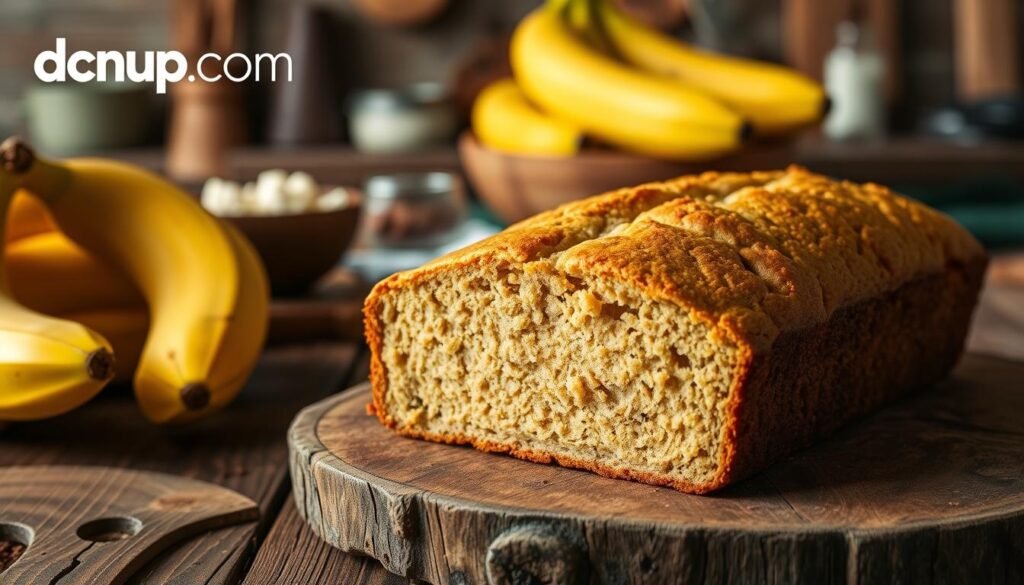High-Altitude Banana Bread: Best Recipe for Elevation
Baking at high elevations can be tricky, but you don’t have to give up on homemade banana bread. Ever wondered how to make the perfect banana bread, no matter where you are? Get ready to improve your baking with our expert advice and the top recipe for high-altitude banana bread.

Key Takeaways
- Discover the secrets to moist and flavorful banana bread at high altitudes.
- Learn how to adjust ingredients and techniques to overcome common baking challenges.
- Explore elevation-proof variations and toppings to personalize your banana bread.
- Troubleshoot issues like dense, dry, or sunken banana bread for perfect results every time.
- Unlock the full potential of your banana bread baking with our comprehensive guide.
Unleash the Perfect Banana Bread at Any Elevation
Baking at high altitudes can be tricky, but with the right tips, you can make the perfect moist banana bread at altitude. Whether you’re a seasoned baker or just starting out, knowing how to make a moist, tasty loaf at high elevations is key. It lets you bake with confidence.
Overcoming Baking Challenges in the Mountains
One big problem when adjusting recipes for mountains is the dry, dense texture. This happens because of the lower air pressure and more evaporation at high altitudes. It can make the bread tough, uneven, and not very tasty.
- Dryness: The air pressure at high elevations makes the batter lose moisture fast, leading to a dry, crumbly texture.
- Dense Texture: The lower air pressure also affects how leavening agents work, making the loaf dense and heavy.
- Uneven Rising: The quick evaporation can cause the bread to rise unevenly, leading to an uneven, sunken surface.
Secrets to Moist and Flavorful Banana Bread at Altitude
To beat these challenges and bake the perfect moist banana bread at altitude, try these tips and adjustments:
- Increase Liquid Ingredients: Add more moist ingredients like mashed bananas, eggs, and milk to make up for the evaporation.
- Adjust Leavening Agents: Use less baking soda or baking powder to avoid over-rising and a dry texture.
- Extend Baking Time: Bake for longer to make sure the center is fully cooked.
- Use a Lower Oven Temperature: Baking at a slightly lower temperature helps prevent the outside from getting too brown before the inside is done.
By using these high-altitude baking tips, you can make a consistently moist, flavorful, and well-risen moist banana bread at altitude. This way, you can enjoy great baking wherever your adventures take you.
Understanding High-Altitude Baking
Baking at high elevations needs a deep understanding of the science behind it. The air pressure is lower, and water boils at a lower temperature. This affects how baked goods rise, bake, and stay moist. So, it’s key to follow seasoned high-elevation bread tips for perfect high-elevation bread.
One big challenge is the fast evaporation of moisture. Water boils sooner because of the lower air pressure. This makes batters and doughs dry out quickly. If recipes aren’t adjusted, baked goods can end up dense, dry, or crumbly.
Also, ingredients like baking soda and baking powder work harder at high elevations. They cause baked goods to rise too much, leading to collapse or tunneling. It’s important to adjust how much and when to use these ingredients for high-elevation bread success.
Knowing these high-altitude baking principles is crucial for perfect high-elevation bread. By making the right adjustments to recipes and techniques, bakers can overcome challenges. They can make high-elevation bread that is moist, flavorful, and well-structured, pleasing to the senses.

“Baking at high altitudes is like a dance with gravity – you have to know the steps to move in perfect harmony with the changing environment.”
Essential Ingredients for Altitude-Friendly Banana Bread
Baking high altitude banana bread requires adjusting key ingredients for a moist, flavorful loaf. We’ll look at the essential parts and how to tweak them for success at high places.
Flour
At higher altitudes, baked goods need less flour because of lower air pressure. Using regular all-purpose flour at sea level can make the bread dense and dry at altitude. Try using pastry or cake flour, which has less protein, and use 2-3 tablespoons less per cup.
Leavening Agents
Leavening agents like baking soda and baking powder are vital in altitude-friendly banana bread. At high elevations, these ingredients work too hard, causing the bread to rise too much. To fix this, cut down the leavening agents by 25-50%.
Additional Ingredients
- Eggs: Add an extra egg to help with structure and moisture.
- Sugar: Cut down sugar by 1-2 tablespoons per cup to avoid dryness.
- Liquid: Add 1-2 tablespoons more liquid (like milk or buttermilk) to balance the dryness.
Adjusting these ingredients will help you make a delicious, altitude-friendly banana bread. It will rise well and stay moist and flavorful, even at high altitudes.

Best Banana Bread Recipe for High Altitude
Getting your banana bread just right at high altitudes is now easier. This recipe is perfect for baking in the mountains or cities with high elevations. It makes a moist, flavorful loaf every time.
The secret is in the special ingredient amounts and baking methods. These are tailored for high-altitude baking. Let’s explore the details:
- Flour: We’ve upped the all-purpose flour to 2 1/4 cups. This helps the bread keep its shape and not collapse.
- Sugar: We’ve cut the white sugar to 3/4 cup. This balances the dryness from lower air pressure.
- Baking Soda: Adding an extra 1/4 teaspoon boosts the bread’s rise. It makes sure the loaf is perfectly risen.
- Eggs: Using 2 large eggs instead of 1 adds moisture and richness.
- Bananas: Mashing 1 1/2 cups of ripe bananas adds natural sweetness and moisture.
By mixing these high-altitude tweaks with classic banana bread methods, you get a delicious result every time. Enjoy the best banana bread recipe for high altitude. It will wow your friends and family, no matter where you are.

Step-by-Step Guide to Baking Banana Bread at Elevation
To make the moist banana bread at altitude just right, you need to use elevated baking techniques. Follow this guide to bake banana bread that looks and tastes great every time.
Preparation
First, get all your ingredients and tools ready. Heat your oven to 350°F (175°C) and grease your loaf pan. Make sure to measure the flour, baking soda, and other dry ingredients accurately. High-altitude baking needs more precision.
Mixing
- In a big bowl, mash the ripe bananas until they’re smooth and creamy.
- Add the eggs, sugar, oil, and other wet ingredients. Mix until they’re well combined.
- Slowly add the dry ingredients. Be careful not to mix too much.
Baking
Pour the batter into your loaf pan and smooth the top. Bake for 55-65 minutes. A toothpick inserted into the center should come out clean. Watch the bread closely in the last 10-15 minutes to avoid overcooking.
Let the banana bread cool in the pan for 10 minutes. Then, move it to a wire rack to cool completely. Slice and enjoy your delicious moist and flavorful high-altitude banana bread!

| Tip | Explanation |
|---|---|
| Adjust Baking Time | At higher elevations, your banana bread may bake faster. So, check it a few minutes earlier than the recipe suggests. |
| Use Parchment Paper | Putting parchment paper in your loaf pan helps prevent sticking. It also makes removing the baked bread easy. |
Adjusting Recipes for Different Altitudes
Baking at higher elevations is a fun challenge for home cooks. The air pressure and other factors can change how your banana bread turns out. But don’t worry, with a few tweaks, you can make moist, tasty banana bread every time.
When adjusting recipes for mountains, remember the air pressure drops. This can make your baked goods rise too fast. They might overflow or become dry and crumbly. To fix this, you need to change your recipe by:
- Reducing the amount of baking soda or baking powder by 15-25%
- Increasing the oven temperature by 15-25°F to help set the structure of the bread before it over-rises
- Reducing the amount of sugar by 1-2 tablespoons to prevent excessive browning
- Adding an extra egg or 1-2 tablespoons of liquid to the batter to help retain moisture
You might also need to adjust the baking time. The lower air pressure can make your banana bread bake faster. So, start checking for doneness a few minutes early than at sea level.
By making these simple changes, you’ll get the perfect high-altitude banana bread. It will be moist, flavorful, and just right for your mountain home. Happy baking!
Troubleshooting Common High-Altitude Baking Issues
Baking banana bread at high elevations can be tricky. You might end up with a dense, dry, or sunken loaf. But, with the right tips, you can fix these problems and bake the perfect banana bread at high elevations.
Solutions for Dense, Dry, or Sunken Banana Bread
If your banana bread is dense, dry, or sunken, there are fixes:
- Reduce Flour: High-altitude baking needs less flour. Try cutting down the flour by 1-2 tablespoons per cup.
- Increase Leavening: At high elevations, you might need more baking soda or baking powder. Add 1/4 to 1/2 teaspoon more.
- Adjust Oven Temperature: Bake at a higher temperature, about 25°F (14°C) above the recipe’s suggestion. This helps the bread rise and prevents sinking.
- Monitor Baking Time: High-altitude baking often takes less time. Check your loaf 5-10 minutes before the recipe suggests for doneness.
By adjusting these simple things, you can solve common high-altitude baking problems. This way, you’ll get a moist, tasty, and well-risen banana bread every time.
High-altitude baking is all about trial and error. Don’t be afraid to try different ingredients and techniques for your elevation. With a bit of troubleshooting, you’ll soon be baking the best high-elevation banana bread.
Elevation-Proof Variations and Toppings
Take your high-altitude altitude-friendly banana bread recipe to the next level with tasty variations and toppings. This section offers ideas to add unique flavors, textures, and looks to your banana bread. Your elevated baked goods will surely impress.
Make your altitude-friendly banana bread stand out by adding special mix-ins. Try adding toasted walnuts, chocolate chips, or a cream cheese swirl for a rich taste. A crunchy streusel topping or caramel sauce can also boost the flavor and texture.
Be bold and try new flavors. Swap vanilla for almond or maple extract for a unique taste. Adding warm spices like cinnamon, nutmeg, or cardamom can deepen your altitude-friendly banana bread recipe.
- Toasted walnuts or pecans for a crunchy texture
- Chocolate chips or chunks for a rich, indulgent flavor
- Cream cheese swirl for a creamy, tangy contrast
- Cinnamon-sugar streusel topping for a delightful crunch
- Caramel or honey drizzle for a sweet finishing touch
| Variation | Description | Impact on Texture and Flavor |
|---|---|---|
| Chocolate Chip | Fold in semi-sweet or milk chocolate chips | Adds richness and a gooey, indulgent texture |
| Cinnamon Swirl | Create a cinnamon-sugar swirl through the batter | Provides a warm, comforting flavor and a beautiful visual appeal |
| Walnut Crunch | Sprinkle toasted walnuts on top of the batter | Enhances the texture with a satisfying crunch |
With these ideas, you can take your altitude-friendly banana bread recipe to new heights. They cater to different tastes and preferences.
Conclusion
Making the best banana bread at high altitudes is possible with the right steps. You need to understand baking science and make smart changes to your recipes. This way, you can always make moist and tasty banana bread, no matter where you bake.
Try different flours, leavening agents, and baking times to get it just right. With some trial and error, you’ll find the perfect recipe. Your friends and family will love it.
So, take on the challenge of baking at high altitudes. Your banana bread will be amazing. Happy baking!
FAQ
What makes a banana bread recipe suitable for high-altitude baking?
To make banana bread for high altitudes, adjust ingredients and baking methods. Use less leavening, more flour, and other tweaks for lower air pressure and faster evaporation.
How do I ensure my high-altitude banana bread turns out moist and flavorful?
For moist, flavorful banana bread at high elevations, use more mashed bananas and extra-large eggs. Adding sour cream or yogurt helps too. Avoid overbaking to prevent dryness.
What are some common baking challenges when making banana bread at high altitudes?
Common challenges include rapid rising, overbrowning, dry texture, and uneven rise. Adjust leavening, flour, and baking time and temperature to solve these issues.
How do I adjust my regular banana bread recipe for high-altitude baking?
To adapt a regular recipe for high altitudes, reduce baking soda or powder, add more flour, and consider extra eggs or high-protein flour. Lower the baking temperature by 25°F and bake longer.
What are some high-altitude-friendly ingredients for banana bread?
For high-altitude banana bread, use extra-ripe bananas, more flour, and ingredients like sour cream or yogurt. These help with moisture and flavor.
How can I troubleshoot common issues with high-altitude banana bread?
If your banana bread is dense, dry, or sunken, try adjusting leavening, flour, and baking time. Watch humidity, oven temperature, and baking times at high elevations.
Can I use the same banana bread recipe for different elevations?
No, using the same recipe at different elevations is not recommended. Adjustments for air pressure, boiling point, and evaporation rates are needed. Use a recipe designed for your elevation or make targeted adjustments.

